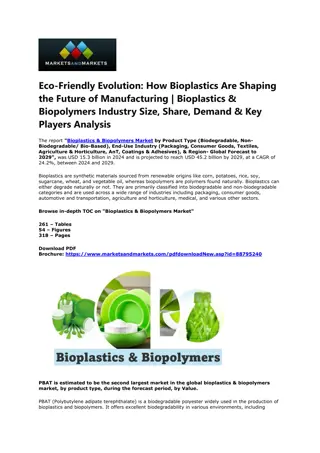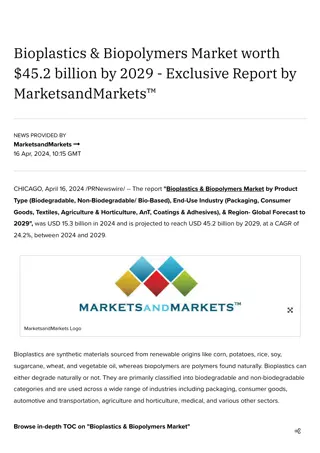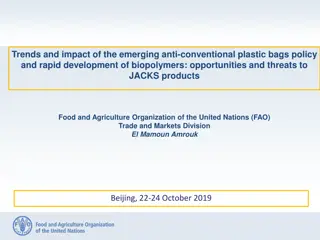Beyond Petroleum: Bioplastics as a Renewable Alternative
Bioplastics are synthetic materials sourced from renewable origins like corn, potatoes, rice, soy, sugarcane, wheat, and vegetable oil, whereas biopolymers are polymers found naturally. Bioplastics can either degrade naturally or not. They are primarily classified into biodegradable and non-biodegra
1 views • 3 slides
Bioplastics & Biopolymers Market worth $45.2 billion by 2029 - Exclusive Report by MarketsandMarkets™
The demand for bioplastics is driven by a combination of environmental concerns, regulatory measures, technological advancements, and consumer preferences. However, several factors also pose challenges to market growth.
1 views • 5 slides
Green Chemistry: Renewable Feedstocks and Biological Processes in Industrial Chemistry
Exploring the 7th principle of Green Chemistry focusing on the use of renewable feedstocks in industrial processes. Examples include transforming waste from seafood and paper industries into valuable materials, utilizing lipids and carbohydrates as feedstocks, and leveraging biological processes to
1 views • 21 slides
Impact of Emerging Anti-Conventional Plastic Bags Policy on Biopolymers: Opportunities & Threats to JACKS Products
The paper discusses the trends and impacts of the emerging anti-conventional plastic bags policy alongside the rapid development of biopolymers, presenting opportunities and threats to JACKS products. It delves into the problematic use of plastics, the boom in the plastic sector, major issues associ
0 views • 11 slides
Understanding Nucleic Acids: The Building Blocks of Life
Nucleic acids, such as DNA and RNA, play a crucial role in storing and transmitting genetic information in living organisms. These biopolymers are composed of nucleotides, each consisting of a sugar, phosphate group, and nitrogenous base. DNA and RNA differ in sugar composition and nucleobases. Nucl
0 views • 14 slides




